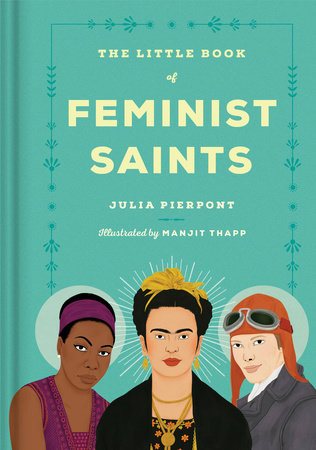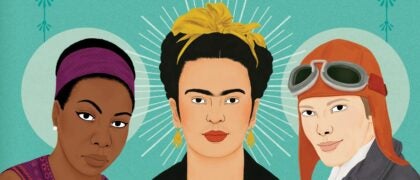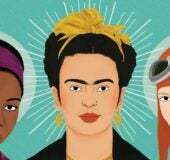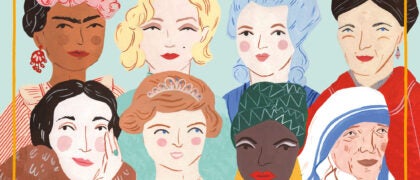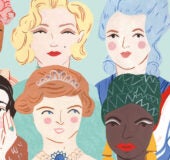Chapter 1
Artemisia Gentileschi
Matron Saint of Artists
b. 1593, Italy
Feast Day: January 1
The judge ordered them to use thumbscrews, to ensure that the victim was telling the truth. There were gynecological exams in court, to confirm that her virginity had been, as she claimed, taken from her. The trial dragged on for eight months, during which time Artemisia never wavered from her testimony: Agostino Tassi, a painter her father had hired to act as her tutor, had raped her. In the end, Tassi, who’d been accused of rape before, was given a one-year sentence that he was never made to serve, and Artemisia was married off, quickly and quietly, and sent away, to Florence, where her real life’s work began. She could neither read nor write, but she could paint. And she did paint: powerful women, women seeking revenge. Her best-known work, Judith Slaying Holofernes, depicts the Old Testament story of the widow Judith decapitating the general Holofernes, with remarkable violence. But it was her own face she used for Judith, and for the face of Holofernes, she painted Agostino Tassi’s. It is the work for which he is remembered now, a man who was meant to be her tutor, and instead became her subject.
Michelle Obama
Matron Saint of Ladies
b. 1964, United States
Feast Day: January 17
We will never have a democracy until we have democratic families and a society without the invented categories of both race and gender. Michelle Obama may have changed history in the most powerful way—by example.
—Gloria Steinem
She went to a magnet school an hour and a half from her home, made the honor roll every year, graduated as salutatorian. But she still remembers the college counselor who told her, “I’m not sure if you’re Princeton material.” She was warned that she was overreaching, that the schools she was applying to were “too much” for her. “Then I got there and I looked around and thought: I’m just as smart as these people,” she recalled. Smarter, it would seem. She graduated cum laude and went on to Harvard Law. When she met her future husband, at the law firm where they both worked, it was as his mentor; twenty years later, he would be sworn in as president. “Any First Lady, rightfully, gets to define her role,” Ms. Obama has said. “There’s no legislative authority; you’re not elected. And that’s a wonderful gift of freedom.” Obama used her freedom to support military families, to combat childhood obesity (an issue that—despite rates having tripled in the twenty years before her husband took office—she knew would be “pooh-poohed as a sort of soft swing at the ball”), and to improve education across the United States, particularly for disadvantaged girls. “Kids are watching us,” she said. “They’re influenced by people they look up to, but it makes us want to live right and do right and be right—Every. Single. Day.—so that we don’t ever disappoint these kids and they have something to hold on to, and so that they know—as I say all the time—I can do this. You can do this.”
Kanno Sugako
Matron Saint of Radicals
b. 1881, Japan
Feast Day: January 24
Rise up, women! Wake up! As in the struggle workers are engaged in against capitalists to break down the class system, our demands for freedom and equality with men will not be won easily just because we will it; they will not be won if we do not raise our voices, if no blood is shed.
—Kanno Sugako
At first, she used her words. Kanno Sugako—Suga to her friends, the daughter of a miner, born in Osaka—ran the local paper after the original publisher was put in jail. “Women in Japan are in a state of slavery,” she wrote. “We have been seen as a form of material property.” When the government sought to shut down that paper, she started new ones. In 1908 she attended a socialist-anarchist rally and saw its leaders thrown in jail. The protest had been a peaceful one; the authorities beat her friends. It was then that Suga recognized the need for “an act of violence that would shake the entire nation to its symbolic foundations.” When the plot to assassinate Emperor Meiji was uncovered, in 1910, twenty-six anarchists were put on trial. Suga was the only woman. “I shall die without whimpering. This is my destiny,” she said in her final statement in court. “I shall die as one of the sacrificial victims. I have no regrets.” In the diary she kept before her hanging, it is clear that she never lost her spirit: “If I could return as a ghost, there are so many people, beginning with the judge of the Court of Cassation, that I would like to terrify. It would be wonderful to scare them witless and make them grovel.”
Virginia Woolf
Matron Saint of Writers
b. 1882, England
Feast Day: January 25
On a crisp October morning at “Oxbridge,” a woman crosses the grass. She has had an idea that excites her, and she is lost in thought. A man intercepts her: only scholars may walk along the turf; women are to stay on the gravel path. The woman complies, and the man moves on. It is a small moment, but the woman has lost her train of thought. She goes to the campus library, wanting to see a manuscript of Thackeray’s. But when she opens the library door, another man is there to meet her: women are not admitted unaccompanied. It is this series of refusals that would become the inspiration and opening to A Room of One’s Own, the feminist rallying text that explored two “unsolved problems”: women and fiction. Virginia Woolf, who owned and operated Hogarth Press with her husband, Leonard, recognized her unique privilege as a woman with artistic freedom. “I’m the only woman in England free to write what I like,” she observed. Woolf’s toughest battle was with her own mind, with the mental illness that eventually drove her to take her own life before the age of sixty. “We cannot, I think, be sure what ‘caused’ Virginia Woolf’s mental illness,” wrote biographer Hermione Lee. “We can only look at what it did to her, and what she did with it. What is certain is her closeness, all her life, to a terrifying edge, and her creation of a language which faces it and makes something of it.” Her diaries reveal a mind unremittingly engaged. In an entry from 1927, while she was working on To the Lighthouse, Woolf wrote, “My brain is ferociously active. I want to have at my books as if I were conscious of the lapse of time; age and death.”
Oprah
Matron Saint of Every Home
b. 1954, United States
Feast Day: January 29
The Oprah Winfrey Show was the number one talk show in America, averaging 12.6 million viewers every single weekday, when its thirty-seven-year-old star put taping on hold to fly east to Capitol Hill. There, she testified before the Senate Judiciary Committee regarding the establishment of a national database of convicted child abusers. “I am committed to using all of my will to follow through on this legislation,” she told the committee. “I intend to make this my second career.” Indeed, she had personally hired an attorney to draft a plan for such a registry. Much has been made of Winfrey’s enormous wealth, as well as her generosity (and penchant for sending her audiences home with free cars), but here was a cause of greater personal significance. Winfrey herself is a survivor of childhood sexual abuse, having been raped on multiple occasions, beginning at age nine—by an uncle, a cousin, and a family friend. It is something she discussed openly on her show, which pioneered a uniquely confessional new format. She connected with audiences because she knew people, and she let them know her. After Winfrey’s testimony in D.C., the committee chairman—and future vice president—Joe Biden told her, “I look forward to your announcement to run for public office.” In 1993, two years after Oprah’s testimony and thirty years after she was first raped, President Clinton signed the National Child Protection Act. They called it the Oprah Bill.
Del Martin and Phyllis Lyon
Matron Saints of Marriage
b. 1921 and 1924, United States
Feast Day: February 12
We would never have marriage equality in California if it weren’t for Del and Phyllis.
—Nancy Pelosi
The first time Dorothy “Del” Martin and Phyllis Lyon were married, it was February 12, 2004. Theirs was the first same-sex wedding in San Francisco, allowed under orders from Mayor Gavin Newsom. Six months later, the union was voided by the California Supreme Court.
The second time Martin and Lyon were married, it was four years later, after the court reversed its decision, legalizing same-sex marriage in California. They wore the same pantsuits they had at their first wedding. Once again, they were first in line.
By that time, they had been a couple for fifty-six years. Together they had founded the Daughters of Bilitis, the first political organization for lesbians in the United States, and edited The Ladder, the first nationally distributed lesbian publication in the country. “We were fighting the church, the couch, and the courts,” Martin recalled. “Nothing was ever accomplished by hiding in a dark corner. Why not discard the hermitage for the heritage that awaits any red-blooded American woman who dares to claim it?” Their second marriage lasted only two months; Martin died in August 2008. “I am devastated,” Lyon said in a statement, “but I take some solace in knowing we were able to enjoy the ultimate rite of love and commitment before she passed.” Seven years later, when the U.S. Supreme Court declared same-sex marriage legal across the country, Lyon, age ninety, said, “Well, how about that?” She laughed and laughed. “For goodness’ sakes.”
Forugh Farrokhzad
Matron Saint of Free Voices
b. 1935, Iran
Feast Day: February 13
She was divorced and wrote about the joys of sex (“a sin all filled with pleasure”). She was an Iranian woman and wrote about the repression that came with that (“Seek your rights, Sister”). She bought cheap paper in bulk, writing thousands of lines she never published. What she did publish earned her a reputation as Iran’s Sylvia Plath. “I never saw her in a state of not being productive, she was like that,” said filmmaker Ebrahim Golestan, her former lover, fifty years after her untimely death (a car accident when she was thirty-two). Farrokhzad described her poetry as “a vital need, a need on the scale of eating and sleeping, something like breathing.” Born in Tehran, she traveled to Europe to “be a woman, that is to say ‘a human being.’ ” But she always came back. At the time of her death, she was planning to perform the title role in a Persian translation of George Bernard Shaw’s Saint Joan, in Tehran. “I love our Tehran, in spite of everything,” she wrote. “I love it and it is only there that my life finds a purpose and reason . . . those heavy sunsets, those dirt roads, and those miserable miscreant corrupt people I love.”
Sappho
Matron Saint of Lovers
b. 630 b.c., E., Greece
Feast Day: February 14
He seems to me an equal of the gods—
whoever gets to sit across from you
—Sappho, translated by Daniel Mendelsohn
Plato called her “the Tenth Muse.” The early church declared her “a sex-crazed whore who sings of her own wantonness.” Though only a fraction of Sappho’s lyric poetry survives today, her significance, both then and now, cannot be overestimated. In 300 b.c., King Seleucus I sent for a doctor to diagnose his son, the crown prince Antiochus. Young Antiochus’s heartbeat was irregular, he fainted, and the color would suddenly fade from his skin. It was observed that his condition became apparent only in the presence of his stepmother, Stratonice. Thus the doctor concluded that Antiochus was suffering from erotic infatuation—because the symptoms were “as described by Sappho”—and Seleucus divorced his wife, giving way for his son to marry her. In modern times, Sappho, who wrote about loving men and women, has served as an icon for lesbian women, with philosopher and gender theorist Judith Butler stating that, as a queer teenager, “As far as I knew, there was only me and a woman called Sappho.”
Barbara Jordan
Matron Saint of the Constitution
b. 1936, United States
Feast Day: February 21
Your mother rides the bus all the way from Houston to Washington, D.C., to see you sworn in. The first woman, the first African American to be elected to Congress from Texas. The Washington Post would later call you “the first black woman everything.” The day of the swearing-in, you wear black, with a white orchid. This becomes a sort of uniform for you, black with white. You don’t mind the extra attention. You would stand out anyway. For your skin, for your sex—most of the other women in Congress were elected to fill their husbands’ terms—for the sheer size of you. Lobbyists whisper in the halls: “She looks like she might be God, if God turns out to be a black woman.” Your private office is far from the House floor, so you set up a makeshift office right there in one of the rows of seats, just off the center aisle, in the eyeline of the presiding officer. You are here to get things done, to use your voice, which is eloquent and strong. As the chairwoman of the Commission on Immigration Reform, you are a staunch defender of birthright citizenship. “I felt somehow for many years that George Washington and Alexander Hamilton just left me out by mistake,” you say. “But through the process of amendment, interpretation, and court decision I have finally been included in ‘We, the people.’ ” You carry a copy of the Constitution in your purse.
Harriet Tubman
Matron Saint of Freedom
b. Approx. 1822, United States
Feast Day: March 10
Much and little is known about the woman whose image may yet displace President Andrew Jackson’s on the twenty-dollar bill. She is an American icon of near-mythical proportions, though we cannot say for certain what year she was born. Her name has become inextricably bound to the Underground Railroad and the slaves she smuggled to freedom. (A former slave herself, she became known as “the Moses of her people.”) She is less widely recognized for her contributions to the Union Army during the Civil War. In June 1863—she would have been around forty—Tubman became the first woman to lead an armed assault during that war. The Combahee River Raid, led by Tubman and Union Colonel James Montgomery, and remembered by The New York Times as “arguably the most beautiful scene ever recorded in a war,” facilitated the escape of more than seven hundred men, women, and children—the largest liberation of slaves in American history. Tubman, who lived until 1913, is even less well known for her contributions late in her life to the cause of women’s rights; she became, according to one biographer, “a grand old lady on the suffrage circuit.” When asked, sometime after the Civil War, if she believed women should have the right to vote, Tubman answered, “I suffered enough to believe it.”
Copyright © 2018 by Julia Pierpont. All rights reserved. No part of this excerpt may be reproduced or reprinted without permission in writing from the publisher.






